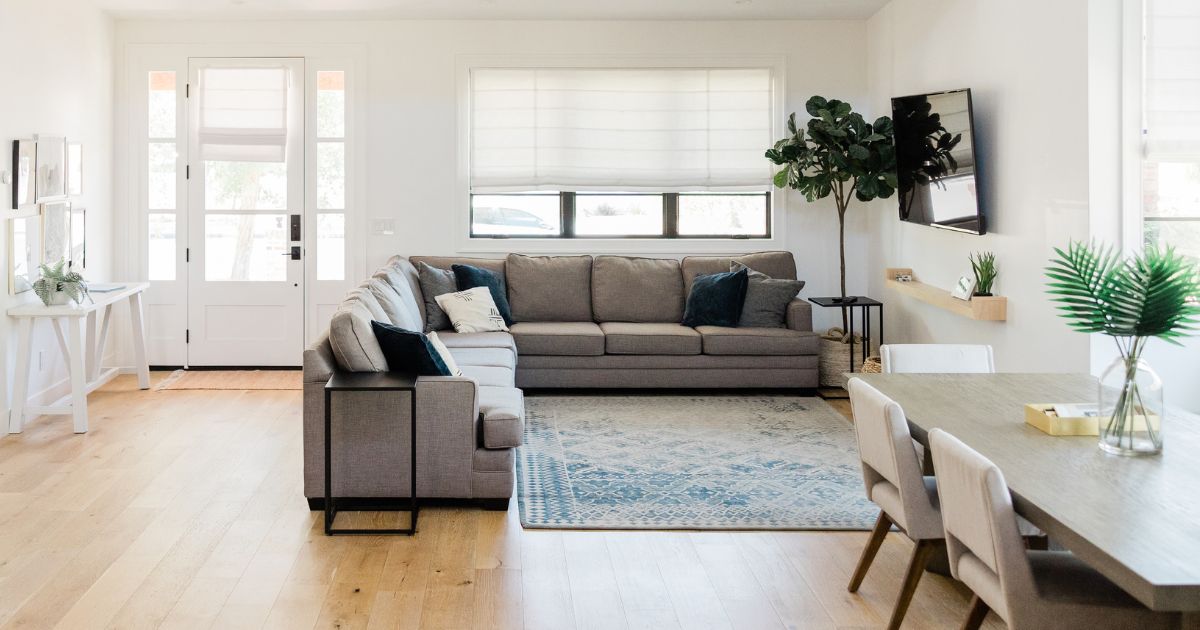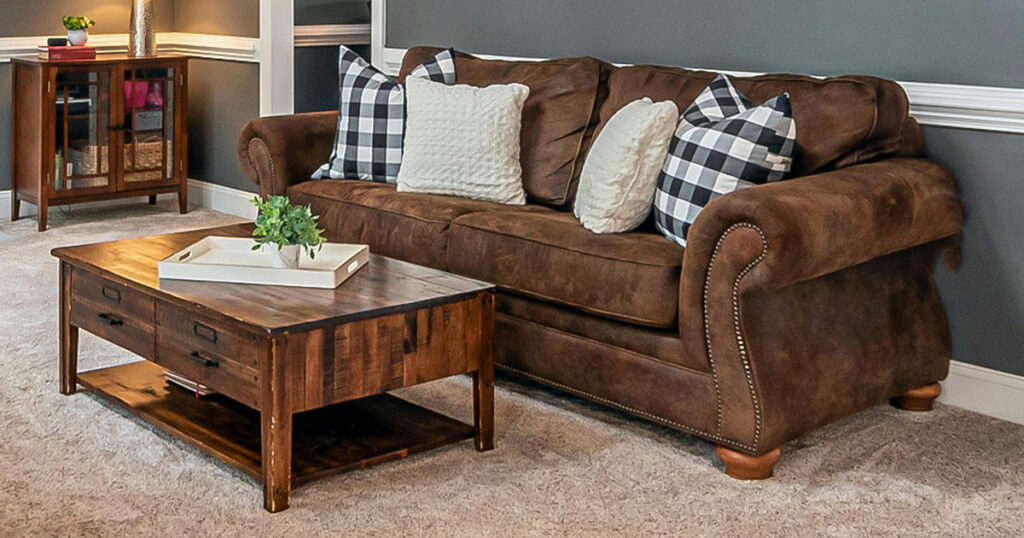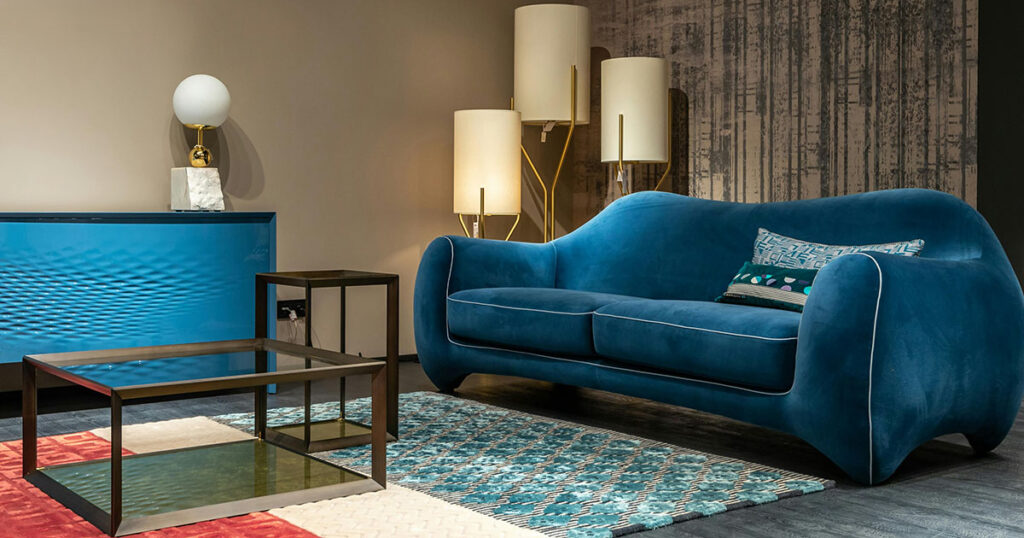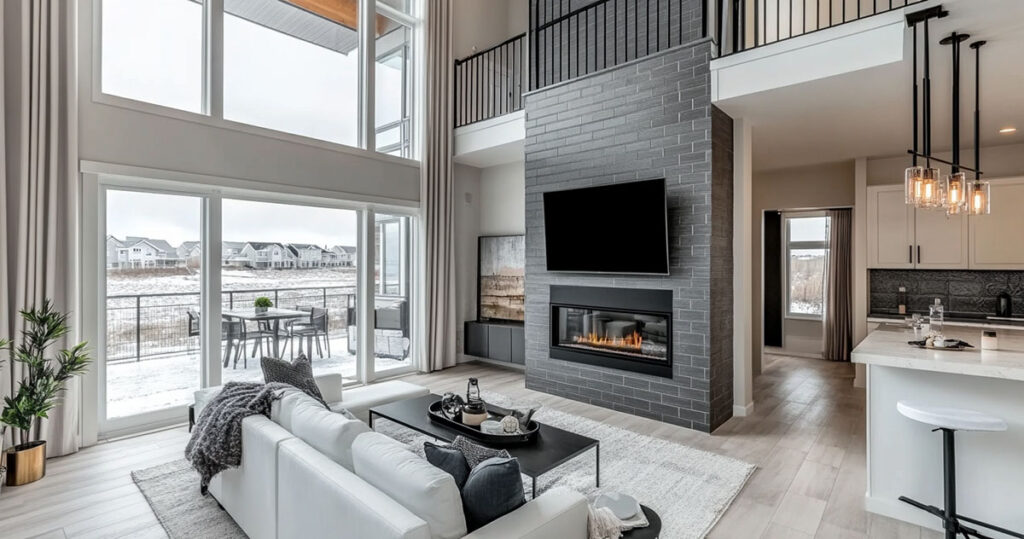This guide will help you navigate rug selection for minimalist spaces, focusing on design aspects rather than durability or maintenance.
Understand minimalist principles and how rugs complement them.
You will be able to choose rugs and carpets that enhance your space’s serene simplicity.
Key Features of Minimalist Interiors
Before selecting a rug, it’s important to recognize what makes a space truly minimalist. Minimalist rooms typically feature a limited color palette of whites, blacks, and neutral tones that create a calm backdrop.
The architecture and furniture emphasize clean lines and geometric shapes without ornate details. These spaces prioritize openness, with minimal furnishings that maximize natural light and flow.
Every piece in a minimalist room serves a purpose, with décor kept to a minimum to avoid clutter. Natural materials like wood, stone, concrete, and plain fabrics add subtle warmth without loud patterns.
A minimalist interior seeks simplicity, functionality, and calm order.
Any rug you introduce should align with these principles.
Common Colors in Minimalist Spaces
Color usage in minimalism is deliberate and restrained:
- Neutral dominance: Walls, floors, and large furniture are usually white, off-white, soft gray, black, or earthy neutral shades.
- Muted accent colors: Occasionally, soft pastels (washed-out pink, sage green, pale blue) or muted earth tones (clay, olive) might appear in small doses.
- Desaturated palette: When colors are used, they tend to be pale and desaturated to maintain serenity.
White, beige, gray, and black form the foundation of minimalist color schemes.
Other hues, if used at all, appear in a restrained way. Understanding this palette will guide your rug choice.
Rug Roles in Minimalist Interiors
Color is crucial when selecting a rug for a minimalist space. Neutral shades like white, ivory, beige, gray, or taupe echo the room’s neutral scheme and create a cohesive look. These colors act as a canvas that complements other design elements.
You might consider monochromatic contrast using black, charcoal, or black-and-white combinations to add graphic interest while adhering to a neutral palette. A rug with a basic black and white pattern adds structure without breaking the minimal vibe.
If you want color, opt for muted, soft tones like pale sage-green, dusty rose, washed-out blue, or mild tan. These introduce personality without overwhelming the space. You can also use tone-on-tone variations within a color family, or balance temperatures with a warm rug in a cool space (or vice versa).
Restraint is key. The rug should complement and quietly elevate the space’s palette, not dominate it.
Rug Colors that Complement Minimalist Interiors
Color is crucial when selecting a rug for a minimalist space. Neutral shades like white, ivory, beige, gray, or taupe echo the room’s neutral scheme and create a cohesive look. These colors act as a canvas that complements other design elements.
You might consider monochromatic contrast using black, charcoal, or black-and-white combinations to add graphic interest while adhering to a neutral palette. A rug with a basic black and white pattern adds structure without breaking the minimal vibe.
If you want color, opt for muted, soft tones like pale sage-green, dusty rose, washed-out blue, or mild tan. These introduce personality without overwhelming the space. You can also use tone-on-tone variations within a color family, or balance temperatures with a warm rug in a cool space (or vice versa).
Restraint is key. The rug should complement and quietly elevate the space’s palette, not dominate it.
Rug Patterns and Designs Suited to Minimalist Style
When it comes to patterns, simpler is better for minimalist spaces. Clean, geometric motifs like stripes, grids, or basic repeating shapes add visual interest without being “loud.” The pattern should be streamlined and understated.
A solid-color rug is a timeless choice that adds texture and defines an area while serving as a neutral base. This keeps attention on other elements. Abstract patterns using large, simple shapes or texture-based designs where pattern comes from pile height differences can also work well.
Steer clear of ornate florals, loud bohemian prints, or intricate designs with multiple motifs and colors. Patterns should enhance, not overpower, complementing the room’s simplicity.
Rug Textures and Pile Types for Minimalist Aesthetics
Texture becomes especially important when color and pattern are subdued. Minimalist designs typically favor rugs with low pile height or flatwoven construction. These appear smooth and tailored, contributing to a sleek look.
While avoiding fussy patterns, play with texture through chunky knit weaves, pebbled loop piles, or slight high-low patterns. Natural fiber rugs like wool, cotton, or jute are excellent choices that introduce organic texture.
Cut pile rugs give a smooth, uniform appearance ideal for a polished minimalist look. Loop pile rugs show a nubbier, textured surface that adds casual warmth. High-pile rugs can work in minimalist settings but should be used intentionally and paired with even more pared-back elements.
The rug’s material will influence its texture and sheen. Natural fibers typically have matte finishes and organic irregularities that suit minimalist interiors. Focus on how the material looks and feels in your space rather than technical specifications.
Handmade vs. Machine-Made Rugs in Minimalist Design
Both handmade and machine-made rugs can work beautifully in minimalist interiors. Handmade rugs offer unique craftsmanship with slight variations that add character and warmth.
High-end minimalist interiors often feature handwoven wool rugs in simple designs. While more expensive, they can be worthwhile investment pieces.
Machine-made rugs provide consistency, affordability, and convenience. They’re often budget-friendly and available in various sizes, colors, and patterns that fit minimalist aesthetics. Their uniform weave aligns well with minimalist precision.
What matters most is choosing a rug with the right color, pattern, and texture for your space, not necessarily how it was made.
Rug Size and Placement in Minimalist Rooms
Correct size and placement are crucial in minimalist interiors. For living rooms, the rug should be proportionate to the seating arrangement, with at least the front legs of furniture on the rug. This ties the seating group together into one zone.
In dining rooms, ensure the rug extends at least 24 inches beyond each side of the table, so chairs remain on the rug even when pulled out. For bedrooms, either use a large area rug extending 18-24 inches beyond the sides and foot of the bed, or place two smaller runners on each side.
Position the rug to align with architecture or key furniture. In open-plan spaces, use different rugs to mark functional areas without walls. Maintain visible floor around the rug’s edges to preserve an open, airy feeling. The rug should feel balanced, contributing to the room’s harmony.
Proper size and placement ensure the rug complements the minimalist space, creating cohesion and highlighting the room’s layout subtly.
Using Rugs for Visual Zoning and Subtle Contrast
Rugs can create visual zones or gentle contrasts within minimalist spaces. They can partition open areas into functional zones while keeping the space open—a form of visual zoning that works without physical dividers.
A rug can also introduce subtle variation in color, texture, or pattern to avoid monotony.
For subtle contrast, try using a shade lighter or darker than your flooring or walls. Add a textured rug in a room full of smooth surfaces to draw the eye. You might use the rug as a singular accent color in an otherwise neutral room, or introduce a subtle pattern among solid-colored elements.
When using rugs for zoning or contrast, ensure all zones read as parts of a unified space. Rugs in different zones should relate to each other through color, material, or style.
Customization: When to Consider Custom Rugs
Custom rugs ensure a perfect fit for your minimalist space. They can match exact dimensions needed for unconventional room shapes or open expanses. You can dictate the precise color palette and design to suit your space, achieving a rug that matches your vision down to the nuance.
Custom services can create rugs in any shape, from perfect circles to abstract forms that mirror architectural elements.
Consider this option when your space has specific requirements not met by available products, or for commercial projects and statement-making designs.
Custom rugs allow you to add personality in a controlled manner. They can become subtle focal points while maintaining minimalist restraint.
Residential vs. Commercial Minimalist Interiors: Rug Considerations
Minimalist principles apply broadly, but there are differences between home and commercial settings. In homes, rugs often focus on creating a tranquil, livable environment. Homeowners may choose softer textures and warmer elements, while still maintaining simplicity.
There’s room for personal expression and coziness as long as it doesn’t disrupt the minimal aesthetic.
In commercial spaces like offices, shops, and hotels, rugs serve strategic purposes like guiding visitors, defining areas, or subtly incorporating brand elements. These spaces often deal with larger scales and may use rugs to signal trends or luxury. While still maintaining minimalist principles, commercial settings might introduce bolder statements through rugs.
In both contexts, minimalist rugs integrate seamlessly into the space’s design. The main differences lie in scale, purpose, and priorities: home rugs focus on comfort and intimacy, while commercial rugs consider impression, brand alignment, and larger layouts.
Ready to Find Your Perfect Minimalist Rug?
We specialize in creating custom rugs that perfectly complement minimalist spaces. From subtle textures to precise sizing, our team can help you find or create the ideal rug for your interior.
Contact us today to discuss your project and take the first step toward elevating your minimalist design with the perfect rug.




